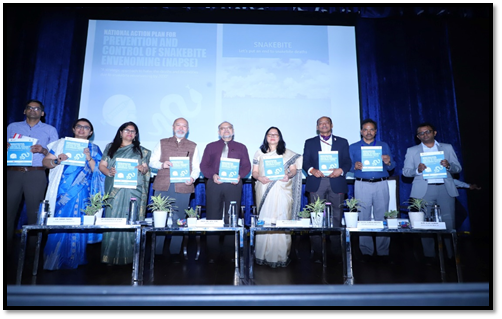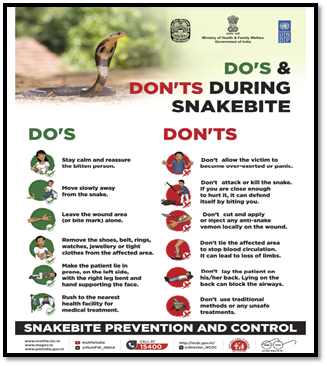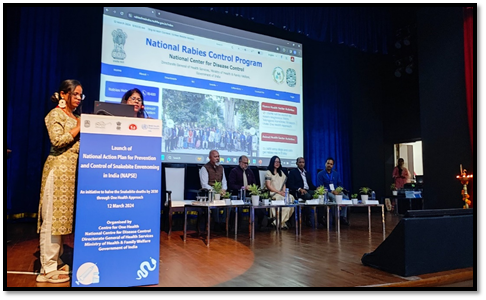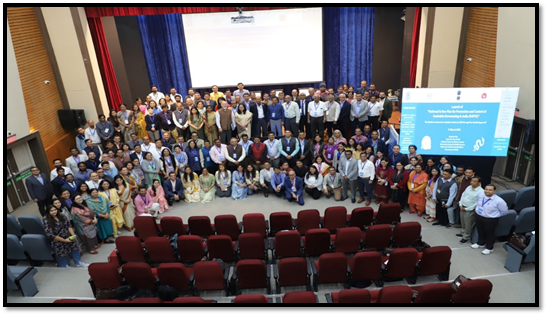Ministry of Health and Family Welfare
Union Health Ministry launches National Action Plan for Prevention and Control of Snakebite Envenoming in India – An Initiative to halve the Snakebite deaths by 2030 through ‘One Health’ Approach
An array of IEC materials including a booklet on Snakebite, Posters on “Dos” and “Don’ts” for general community and a 7-minute video on Snakebite Awareness also launched
Snakebite Helpline, a vital resource that will provide immediate assistance, guidance, and support to individuals and communities affected by snakebite incidents will be piloted in five States
National Rabies Control Programme Website also launched
National One Health Programme for Prevention and Control of Zoonoses onboarded on the Integrated Health Initiative Platform to strengthen surveillance of zoonotic diseases in the country
प्रविष्टि तिथि:
12 MAR 2024 5:17PM by PIB Delhi
Shri Apurva Chandra, Union Health Secretary launched a National Action Plan for Prevention and Control of Snakebite Envenoming (NAP-SE) in India, here today. With a vision to reduce snakebite deaths by halve by 2030, NAPSE provides a broad framework for states to develop their own action plan for management, prevention and control of snakebites through the ‘One Health’ approach. The activities envisaged under human, wildlife, tribal and Animal health component will be undertaken by concerned stakeholders at all levels.

An array of IEC materials were also launched on the occasion which includes:
- A booklet on ‘Snakebite - Let’s put an end to snakebite deaths’: this booklet will be used for creating awareness in the general community;
- Posters on Do’s and Don’ts for general community; and
- A 7-minute video on Snakebite Awareness for General Community.
These materials will serve as invaluable tools for raising awareness, disseminating critical information, and empowering communities to take proactive measures against snakebite.

It was informed that a Snakebite Helpline no (15400), a vital resource that provides immediate assistance, guidance, and support to individuals and communities affected by snakebite incidents will be piloted in five States (Puducherry, Madhya Pradesh, Assam, Andhra Pradesh and Delhi). This initiative aims to ensure prompt access to medical care and information to general public.
A National Rabies Control Programme Website was also launched on the occasion. It is a comprehensive online platform dedicated to providing resources, updates, and insights on Rabies. This website will serve as a digital platform for States/UT for entering information related to animal bite and rabies; this will also help the community to assess the nearest Anti Rabies Clinic and Infectious disease hospital for management of animal bite and rabies cases. The website will also help in send the reminder SMS for vaccination follow up.

The National One Health Programme for Prevention and Control of Zoonoses was also onboarded on the Integrated Health Initiative Platform. This initiative will help in strengthening the surveillance of zoonotic diseases in the country.

Background:
Snakebite envenoming is a potentially life-threatening disease following the bite of a venomous snake. Venomous snake bites can result in medical issues which can be deadly or lead to permanent impairment if timely and appropriate treatment is not given. The majority of snakebite envenomation deaths and catastrophic sequelae can be avoided with prompt availability to safe and effective antivenoms, timely transport and referral.
In India, around 50,000 deaths occur of an estimated 3-4 million snakebites annually which accounts for half of all snakebite deaths globally. Only a small proportion of snake bite victims across countries report to the clinics and hospitals and actual burden of snake bite is grossly underreported. As per the Central Bureau of Health Investigation (CBHI) reports (2016-2020), the average annual frequency of snakebite cases in India is around 3 lakhs and about 2000 deaths occur due to snakebite envenoming.
In India, around 90% of snakebites are caused by the 'big four' among the crawlers - common krait, Indian cobra, Russell's viper and saw scaled viper. Administration of polyvalent anti-snake venom (ASV) containing antibodies against cobra, Russell’s viper, common krait and saw scaled viper is effective in 80% of the snakebite cases, however, lack of trained human resources and health facilities to treat snakebite patients remains a cause of concern. Also, the unavailability of data on incidence, morbidity, mortality, socio-economic burden, treatment patterns etc. are the major hindrances in planning for mitigation of snakebite in India.
Vision & Mission of NAPSE
Vision: “To prevent and control snakebite envenoming in order to halve the numbers of deaths and cases of disability that it causes by 2030”
Mission: To progressively reduce the morbidity, mortality and its associated complications in humans due to Snake bite
The National Action Plan for Snakebite Envenoming (NAPSE) provides a broad framework for management, prevention and control of Snake bite envenoming in India. This NAP-SE echoes the global voice of reducing the deaths due to snakebite envenoming by half and envisages all strategic components, roles and responsibilities of concerned stakeholders.
The NAP-SE is a guidance document for the states / UTs and stakeholders to develop their own action plan, specific to their needs and aims at systematic reduction of snakebite envenoming risk through sustained availability of anti-snake venom, capacity building, referral mechanism and public education.
The NAPSE has identified key stakeholders, supporting stakeholders and other partner institutes based on their mandates, existing roles and responsibilities. Key stakeholders will act as a nodal agency for the overall formulation, planning, coordination and implementation of the activities as envisaged under National and State Action Plan for Prevention and Control of Snakebite Envenoming. They will be directly involved for providing technical and logistic support to the State/District and below level. They will also help in formalizing the State Action Plan for Prevention and Control of Snakebite Envenoming.
Supporting stakeholders are those who would be assisting the key stakeholders in coordination and implementation of various aspects of the NAPSE. They will provide technical assistance in activities planned for prevention and control of snakebite envenoming from India under various components.
Other stakeholders will include NGOs active in the field of snakebite in health, wildlife, and veterinary sectors, professional organizations and associations in medical and veterinary sector and international development organizations. They would be primarily assisting in implementation of the NAPSE with the available logistics and expertise and provide support to the key stakeholders at the field level.
The NAPSE has identified key strategic actions to be undertaken for operationalization of human, wildlife and animal component. The strategic action for human health component includes ensuring provision of anti snake venom at all health facilities, strengthening surveillance of snake bite cases and deaths in humans, strengthening of emergency care services at District Hospitals/ CHCs including services for ambulance, institutionalization of Regional Venom Centre’s and inter-sectoral coordination. The strategic action for wildlife health component includes education awareness, antivenom distribution, strengthening of the key stakeholders, systematic research and monitoring and snake venom collection and snake relocation. The strategic action for animal and agriculture component includes prevention of snake bites in livestock, community engagement etc.
The NAPSE envisages a step wise approach for the States to develop their own Action Plan as per their needs. The activities envisaged under human, wildlife, tribal and animal health component will be undertaken by concerned stakeholders at all levels. The states will identify and nominate State and District Nodal Officer (SNO & DNO) to coordinate with SNO and DNO of SBPC.
The activities of human health component are already being implemented under snakebite prevention and control through the State and District Nodal Officer (SNO & DNO) under National Health Mission. Surveillance is a key element in NAPSE so that problems can be easily identified, and actions could be undertaken taken in a timely manner. The NAPSE has defined joint monitoring mechanisms with specific indicators for both human, wildlife and animal health components at all levels, independent component wise monitoring by the concerned stakeholder and independent external evaluation of the state action plan. This document describes phase wise activity matrix and road map for State action plans.
Dr Atul Goel, Director General of Health Services, Ministry of Health and Family Welfare; Smt. L S Changsan, Addl. Secretary and MD (NHM), Ministry of Health and Family Welfare; Shri Sushil Kumar Awasthi, Addl. Director General of Forest (WL), Ministry of Environment, Forest and Climate Change; Dr Simmi Tiwari, Joint Director & Head, Centre for One Health, National Centre for Disease Control (NCDC); Dr Roderico H Ofrin, WHO Representative to India and senior officials of the Union Government were present on the occasion.
*****
MV
HFW/HFM Launch of NAP on Snakebite/12thMarch2024/1
(रिलीज़ आईडी: 2013803)
आगंतुक पटल : 12530